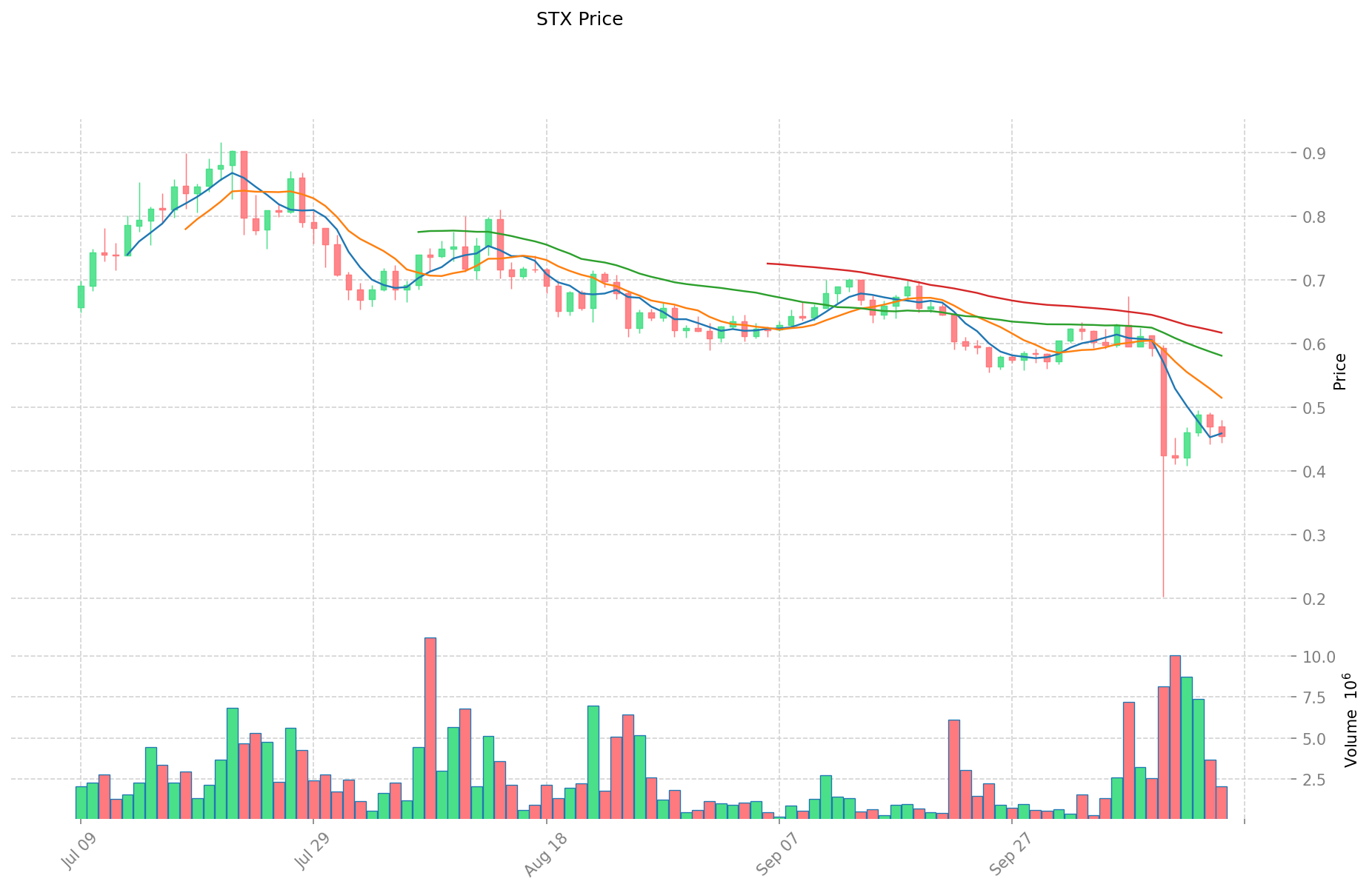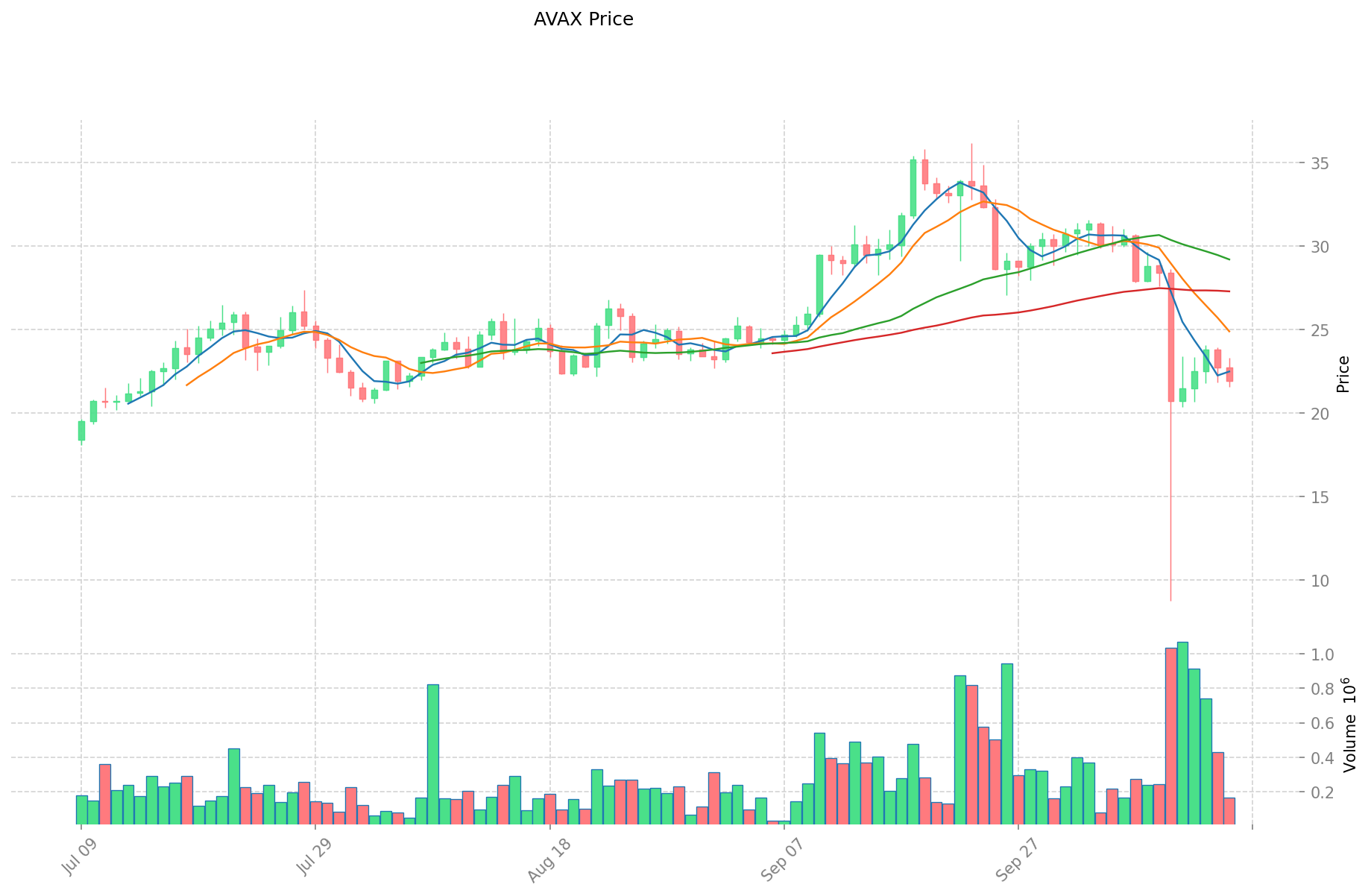STX vs AVAX: Comparing Two Rising Stars in the Blockchain Ecosystem
Introduction: STX vs AVAX Investment Comparison
In the cryptocurrency market, the comparison between Stacks (STX) and Avalanche (AVAX) has always been a topic that investors can't ignore. The two not only have significant differences in market cap ranking, application scenarios, and price performance, but also represent different positioning in crypto assets.
Stacks (STX): Since its launch in 2020, it has gained market recognition for its vision of a new decentralized internet with built-in privacy and user data control.
Avalanche (AVAX): Introduced in 2020, it has been hailed as a platform for launching decentralized applications and interoperable blockchains, known for its fast transaction finality and Ethereum compatibility.
This article will provide a comprehensive analysis of the investment value comparison between STX and AVAX, focusing on historical price trends, supply mechanisms, institutional adoption, technological ecosystems, and future predictions, attempting to answer the question that concerns investors the most:
"Which is the better buy right now?"
I. Price History Comparison and Current Market Status
STX and AVAX Historical Price Trends
- 2021: STX reached its all-time high of $3.86 due to increased adoption and market optimism.
- 2021: AVAX hit its peak of $144.96 in November, driven by growing interest in layer-1 alternatives.
- Comparative analysis: During the 2022 bear market, STX dropped from its high to a low of $0.24, while AVAX declined to $9.53, showing significant corrections for both assets.
Current Market Situation (2025-10-16)
- STX current price: $0.4534
- AVAX current price: $21.86
- 24-hour trading volume: STX $990,617,435 vs AVAX $3,597,368,454
- Market Sentiment Index (Fear & Greed Index): 28 (Fear)
Click to view real-time prices:
- Check STX current price Market Price
- Check AVAX current price Market Price


Investment Value Analysis: STX vs AVAX
Technical Development and Ecosystem Building
- AVAX: AVAX has positioned itself as a valuable Layer 1 blockchain due to its high performance capabilities. It benefits from Ethereum's current limitations in speed and cost, offering faster and cheaper transactions while ETH 2.0 focuses primarily on environmental aspects rather than fee reduction.
- STX: STX operates in the competitive Ethereum Layer 2 ecosystem, where it faces strong competition from leading projects like ARB (Arbitrum).
- Ecosystem Comparison: AVAX is categorized as a high-performance Layer 1 blockchain similar to Solana, potentially seeking ETF approval to enter traditional financial markets. The DeFi ecosystem development on both platforms remains a critical factor for their long-term success.
Institutional Adoption and Market Applications
- ETF Potential: AVAX (along with SUI and NEAR) is positioned to potentially benefit from ETF approval, which could establish it as part of the next wave of high-performance blockchain beneficiaries following Bitcoin and Ethereum.
- Market Positioning: AVAX is projected to have an average trading value of $72.79 in 2024, positioning it as a potential top cryptocurrency for the year (from a 2023 value of $55.42).
- US Policy Impact: The cryptocurrency market is increasingly influenced by US policy factors, including ETF applications and political endorsements, which could affect both tokens differently based on regulatory developments.
Macroeconomic and Market Cycles
- Market Trends: SOL's ecosystem activity exceeds that of mainstream coins, with potential capital overflow benefiting AVAX and NEAR in related market movements.
- Bull Market Potential: Both tokens have different positioning in the current market cycle, with AVAX specifically mentioned as potentially benefiting from broader cryptocurrency market growth in 2024.
- Investment Strategy Context: These assets represent different risk-reward profiles within a diversified cryptocurrency portfolio strategy, with their performance tied to broader Layer 1 and Layer 2 blockchain adoption trends.
III. 2025-2030 Price Prediction: STX vs AVAX
Short-term Prediction (2025)
- STX: Conservative $0.42 - $0.45 | Optimistic $0.45 - $0.57
- AVAX: Conservative $13.76 - $21.84 | Optimistic $21.84 - $31.67
Mid-term Prediction (2027)
- STX may enter a growth phase, with an estimated price range of $0.48 - $0.85
- AVAX may enter a consolidation phase, with an estimated price range of $28.81 - $35.29
- Key drivers: Institutional capital inflow, ETF, ecosystem development
Long-term Prediction (2030)
- STX: Base scenario $0.82 - $1.00 | Optimistic scenario $1.00 - $1.17
- AVAX: Base scenario $40.89 - $48.86 | Optimistic scenario $48.86 - $56.84
Disclaimer
STX:
| 年份 | 预测最高价 | 预测平均价格 | 预测最低价 | 涨跌幅 |
|---|---|---|---|---|
| 2025 | 0.567 | 0.4536 | 0.421848 | 0 |
| 2026 | 0.709317 | 0.5103 | 0.387828 | 12 |
| 2027 | 0.8537319 | 0.6098085 | 0.47565063 | 33 |
| 2028 | 0.826900326 | 0.7317702 | 0.643957776 | 60 |
| 2029 | 0.86506214193 | 0.779335263 | 0.71698844196 | 71 |
| 2030 | 1.1675221575003 | 0.822198702465 | 0.657758961972 | 80 |
AVAX:
| 年份 | 预测最高价 | 预测平均价格 | 预测最低价 | 涨跌幅 |
|---|---|---|---|---|
| 2025 | 31.668 | 21.84 | 13.7592 | 0 |
| 2026 | 37.99068 | 26.754 | 25.95138 | 21 |
| 2027 | 35.2858506 | 32.37234 | 28.8113826 | 47 |
| 2028 | 46.345860561 | 33.8290953 | 21.988911945 | 54 |
| 2029 | 41.69097704772 | 40.0874779305 | 30.065608447875 | 82 |
| 2030 | 56.8360262098629 | 40.88922748911 | 28.622459242377 | 86 |
IV. Investment Strategy Comparison: STX vs AVAX
Long-term vs Short-term Investment Strategies
- STX: Suitable for investors focused on Layer 2 solutions and Bitcoin ecosystem integration
- AVAX: Suitable for investors interested in high-performance Layer 1 platforms and DeFi ecosystem growth
Risk Management and Asset Allocation
- Conservative investors: STX: 30% vs AVAX: 70%
- Aggressive investors: STX: 50% vs AVAX: 50%
- Hedging tools: Stablecoin allocation, options, cross-currency portfolios
V. Potential Risk Comparison
Market Risks
- STX: Potential volatility due to Bitcoin market correlation
- AVAX: Exposure to Layer 1 competition and market sentiment shifts
Technical Risks
- STX: Scalability, network stability in relation to Bitcoin blockchain
- AVAX: Network congestion during high demand, potential security vulnerabilities
Regulatory Risks
- Global regulatory policies may impact both differently, with AVAX potentially benefiting from ETF approvals
VI. Conclusion: Which Is the Better Buy?
📌 Investment Value Summary:
- STX advantages: Bitcoin ecosystem integration, potential for Layer 2 growth
- AVAX advantages: High-performance Layer 1, strong DeFi ecosystem, potential ETF approval
✅ Investment Advice:
- New investors: Consider a balanced approach with a slight preference for AVAX due to its broader ecosystem and potential ETF benefits
- Experienced investors: Explore a diversified portfolio including both STX and AVAX, adjusting based on risk tolerance and market trends
- Institutional investors: Focus on AVAX for its potential inclusion in ETFs and strong positioning in the Layer 1 space
⚠️ Risk Warning: The cryptocurrency market is highly volatile, and this article does not constitute investment advice. None
FAQ
Q1: What are the main differences between STX and AVAX? A: STX is focused on Layer 2 solutions and Bitcoin ecosystem integration, while AVAX is a high-performance Layer 1 platform. STX is more closely tied to Bitcoin's performance, whereas AVAX has its own independent ecosystem and potential for ETF approval.
Q2: Which token has performed better historically? A: Both tokens reached all-time highs in 2021, with STX peaking at $3.86 and AVAX at $144.96. However, AVAX has shown stronger overall performance and market capitalization.
Q3: What are the price predictions for STX and AVAX by 2030? A: By 2030, STX is predicted to reach $0.82 - $1.17 in optimistic scenarios, while AVAX is expected to reach $40.89 - $56.84 in optimistic scenarios.
Q4: How do the ecosystems of STX and AVAX compare? A: AVAX has a more developed DeFi ecosystem and is positioned as a high-performance Layer 1 blockchain. STX operates in the competitive Ethereum Layer 2 ecosystem and faces strong competition from other projects.
Q5: Which token might be better for institutional investors? A: AVAX might be more attractive to institutional investors due to its potential inclusion in ETFs and strong positioning in the Layer 1 space.
Q6: What are the main risks associated with investing in STX and AVAX? A: STX faces risks related to Bitcoin market correlation and scalability issues. AVAX risks include exposure to Layer 1 competition, potential network congestion, and security vulnerabilities.
Q7: How might regulatory changes affect STX and AVAX differently? A: Global regulatory policies may impact both tokens differently, with AVAX potentially benefiting more from ETF approvals and broader institutional adoption.
Share
Content